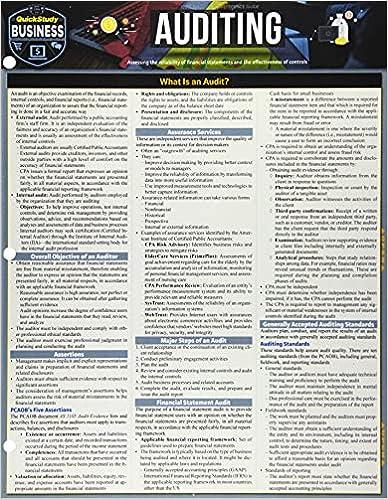Question
11- The capital maintenance perspective that considers the changes in the real value of the currency unit is: A- Financial capital maintenance B- Purchasing power
11- The capital maintenance perspective that considers the changes in the real value of the currency unit is:
A- Financial capital maintenance
B- Purchasing power maintenance
C- Physical capital maintenance
D- None of the above
12- The accounting alternative method that adjusts the historical cost accounting numbers, is called:
A-Current purchasing power accounting
B- General price level accounting
C- Current cost accounting
D- A and B
13- Which of the following is monetary asset:
A- Cash
B- Inventory
C- Buildings
D- Lands
14- If the company has more monetary assets than monetary liabilities, then, in the periods of inflation, the company will have:
A- Gain
B- Loss
C- No gain, no loss
D- A and B
15- The accounting method that differentiates between trading profits and holding gains, is:
A-Current purchasing power accounting
B- General price level accounting
C- Current cost accounting
D- Historical cost accounting
16- Limitations of historical cost accounting enhance the need for:
A- Accounting for changing prices
B- International accounting
C- Accounting for income tax
D- The conceptual framework of accounting
17- The two primary qualities that make accounting information useful for decision making are
A- Comparability and consistency
B- Materiality and timeliness.
C- Relevance and reliability.
D- Reliability and comparability.
18- Advantages of development of conceptual framework include, except:
A- Enhancing the consistency of accounting standards
B- More compatible accounting standards
C- Alleviating political pressure
D- Reducing the decision usefulness role of financial reports
19- David (1998) implemented a research to investigate the relationship between earnings manipulation and borrowing orientation; such research is:
A- Explanatory theory research
B- True income theory research
C- Positive theory research
D- Decision makers theory research
E- Both A & C are correct answers
20- Flora Guidry, Andrew J. Leone, and Steve Rock (1999) tests the bonus-maximization hypothesis that managers make discretionary accrual decisions to maximize their short-term bonuses, such theorizing should be classified as:
A-Bonus plan theory
B-Debt theory
C-Political cost theory
D-True income theory
21- Lan Sun (2012) sheds light in explaining contractual incentives and provides useful information in understanding the executive compensation contract-driven earnings management behavior, such theorizing should be classified as:
A-Bonus plan theory
B-positive accounting theory
C-Political cost theory
D- A & B
Step by Step Solution
There are 3 Steps involved in it
Step: 1

Get Instant Access to Expert-Tailored Solutions
See step-by-step solutions with expert insights and AI powered tools for academic success
Step: 2

Step: 3

Ace Your Homework with AI
Get the answers you need in no time with our AI-driven, step-by-step assistance
Get Started


